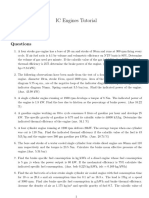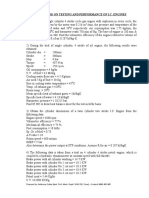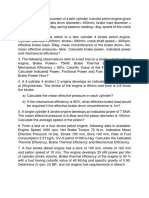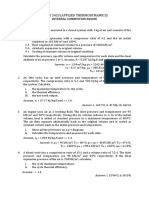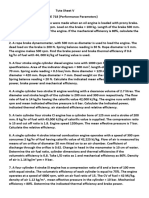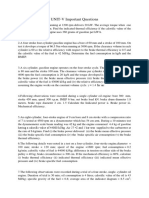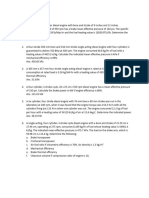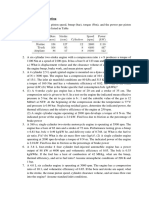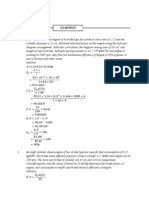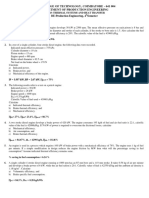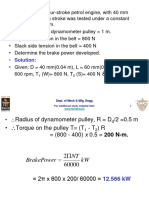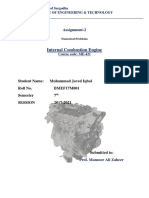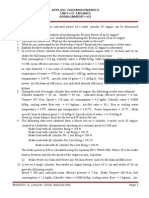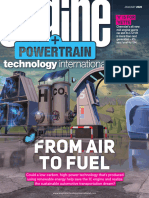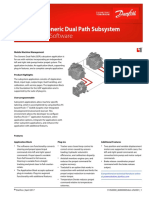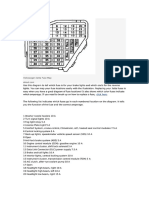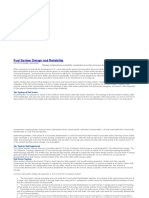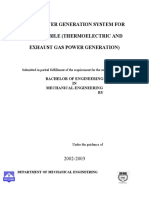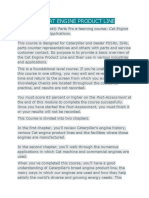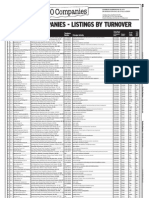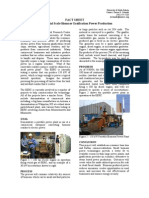TUTORIAL : Engine Performance and
Testing of Engines
1. Following observations were recorded during a test on a single cylinder 4- stroke oil engine
Bore =300mm; Stroke = 450mm; Speed =300rpm; imep = 6bar; Net brake load = 1.5 kN; Brake drum
diameter = 1.8m; Brake rope diameter = 2 cm.
Calculate: (i) Indicated Power
(ii) Brake Power
(iii) Mechanical Efficiency [47.71 KW;42.88 kw;89.87%]
2. The following data refers to a petrol engine working on OTTO four stroke cycle.
Brake Power = 14.7 kW
Suction Pressure = 0.9 bar
Mech. Efficiency = 80%
Compression Ratio = 5
Index of Compression curve = 1.35
Index of expansion curve = 1.3
Maximum Explosion pressure = 24 bar
Engine Speed = 1000 r.p.m
Ratio of stroke to bore = 1.5
Find the diameter and stroke of piston[0.1527 m;229.2 mm]
3. A four cylinder two stroke cycle petrol engine develops 30 KW at 2500rpm. The mean effective
pressure on each piston is 8 bars and mechanical efficiency is 80%. Calculate the diameter and
stroke of each cylinder with stroke bore ratio 1.5. Also calculate the fuel consumption of the
engine, if brake thermal efficiency is 28%. The calorific value of fuel is 43900 kJ/ kg.[62 mm ;93
mm;8.78 Kg/ hr]
4. A 4-cylinder petrol engine works on a mean effective pressure of 5 bar and engine speed of 1250
r.p.m. Find the indicated power developed by the engine if the bore is 100 mm, and stroke 150
mm.
[Ans. 6.11 kW]
�5. A 4-cylinder, four stroke diesel engine runs at 1000 r.p.m. The bore and stroke of each cylinder
are 100 mm and 160 mm respectively. The cut off is 6.62% of the stroke. Assuming that the
initial condition of air inside the cylinder is 1 bar and 200 C, mechanical efficiency of 75% ;
Calculate the air-standard efficiency and brake power developed by the engine.Also, calculate
the brake specific fuel consumption if the air/fuel ratio is 20: 1. Take R for air as 0.287 kJ/kg K
and clearance volume as 0.000084 m3.
[Ans. 61.4%, 21.75kW, 0.4396 kg/kW]
6. A four stroke gas engine develops 4.2 kW at 180 r.p.m. and at full load. Assuming the following
data, calculate the relative efficiency based on indicated power and air-fuel ratio used.
Volumetric efficiency= 87 %, mechanical efficiency =74%, clearance volume = 2100 cm 3, swept
volume = 9000 cm3, fuel consumption = 5 m3/h, calorific value of fuel = 16750 kJ/m3.
[Ans. 50.2%, 7.456:1]
7. The following observations were recorded during a trial of a four stroke engine with
rope brake dynamometer:Engine speed = 650 r.p.m., diameter of brake drum = 600 mm,
diameter of rope = 50 mm, dead load on the brake drum = 32 kg, spring balance reading = 4.75
kg.Calculate the brake power.
[Ans. 5.9 kW]
8. During a 60 minutes trial of a single cylinder four stroke engine the following observations were
recorded:Bore = 0.3 m, stroke = 0.45 m, fuel consumption = 11.4 kg, calorific value of fuel =
42000 kJ/kg, brake mean effective pressure = 6.0 bar, net load on brakes = 1500 N, r.p.m. = 300,
brake drum diameter = 1.8 m, brake rope diameter = 20 mm, quantity of jacket cooling water
600 kg, temperature rise of jacket water =550C, quantity of air as measured = 250 kg, exhaust
gas temperature = 4200C, cp for exhaust gases = 1 kJ/kg K, ambient temperature = 200C.
Calculate: (i) Indicated power; (ii) Brake power;
(iii) Mechanical efficiency (iv) Indicated thermal efficiency.
Draw up a heat balance sheet on minute basis.
[Ans. (i) 47.7 kW; (ii) 42.9 kW; (iii) 89.9%, (iv) 35.86%]
9. A two-cylinder four stroke gas engine has a bore of 380 mm and a stroke of 585 mm. At 240
r.p.m. the torque developed is 5.16 kN-m.Calculate: (i) Brake power (ii) Mean piston speed in
m/s (iii) Brake mean- effective pressure.
[Ans. (i) 129.8 kW; (ii) 4.68 m/s; (iii) 4.89 bar]
10. A 4-cylinder, four-stroke diesel engine has a bore of 212 mm and a stroke of 292 mm. At full
load at 720 r.p.m., the b.m.e.p. is 5.93 bars and the specific fuel consumption is 0.226 kg/kWh.
The air/fuel ratio as determined by exhaust gas analysis is 25: 1. Calculate the brake thermal
efficiency and volumetric efficiency of the engine.Atmospheric conditions are 1.01 bar and 150C
and calorific value for the fuel may be taken as 44200 kJ/kg.
[Ans. 36%; 76.5%]
11. During the trial (60 minutes) on a single cylinder oil engine having cylinder diameter 300 mm,
stroke 450 mm and working on the four stroke cycle, the following observations were made
:Total fuel used = 9.6 liters, calorific value of fuel = 45000 kJ/kg, total number of revolutions =
12624, gross indicated mean effective pressure = 7.24 bar, pumping i.m.e.p. = 0.34 bar, net load
on the brake = 3150 N, diameter of brake wheel drum = 1.78 m, diameter of rope = 40 mm,
�cooling water circulated = 545 liters, cooling water temperature rise = 250 C, specific gravity of
oil = 0.8.Determine: (i) Indicated power. (ii) Brake power. (iii) Mechanical
efficiency.Draw up the heat balance sheet on minute basis.
[Ans. (i) 77 kW; (ii) 61.77 kW; (iii) 80.22%
Best Of Luck

